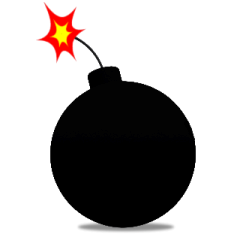Born in Northampton, England, in 1953, Alan Moore’s comics writing was nothing short of seminal in the 1980s with Watchmen and nothing less than monumental in the 1990s with From Hell. In this interview, he talks about his comics work in great detail, as well as his non-comics writing, his CDs and his interest in the occult. Full of insights, his conversation touches upon many other social and cultural subjects which should be of interest to Blather readers.
Some familiarity with Watchmen and From Hell is advised, as Barry Kavanagh’s questions are based on close readings of these books. What is being said about the other works is probably understandable from the context. Nevertheless, here’s a brief, helpful rundown on some of the works that are discussed:
V for Vendetta, with artist David Lloyd (collected by DC Comics, 1990), originally began in 1981 in the English magazine Warrior, which was discontinued. Moore and Lloyd managed to pick it up a few years later and finished it in 1988. It tells the story of a dystopian future England, governed by fascists. A mysterious Guy Fawkes lookalike called V emerges, seemingly from nowhere, and blows up the houses of parliament. And that’s just the first six pages…
Watchmen, with artist Dave Gibbons (collected by Titan Books, 1987) shows how the Cold War would have been conducted if a superhuman being had existed. There are also various “masked adventurers” in the story, which completely twists and undermines superheroes and the superhero comic genre. Many philosophical issues are brilliantly addressed, including the value of human life.
Batman: The Killing Joke, with artists Brian Bolland and John Higgins (DC Comics, 1988), about the relationship between Batman and the Joker, was one of the Batman stories “for mature readers” that were in high demand in the wake of Frank Miller’s reinterpretation of Batman in 1986-87 (the Batman movie killed all that off).
Brought to Light, with artist Bill Sienkiewicz (Titan Books, 1989), was based on the lawsuit filed by the Christic Institute against drug-smuggling, arms-dealing servants of the US government.
Big Numbers, with artist Bill Sienkiewicz (Mad Love, 1990), was the ill-fated, unfinished comic about a young writer called Christine.
A Small Killing, with artist Oscar Zarate (Victor Gollancz, 1991), told the story of Timothy Hole, who works in advertising in New York and is being followed by a mysterious little boy, even when he returns home to Sheffield.
From Hell, with artist Eddie Campbell (Mad Love / Kitchen Sink Press, 1991-96), is a fictional account of the Jack the Ripper crimes of 1888, based on exhaustive research.
The Birth Caul, with musicians Tim Perkins and David J (1995), is a spoken word performance. Moore talks about “this present moment,” then takes us back through adulthood, adolescence, childhood, birth, to before birth, to earlier forms of evolution, to the periodic table, to the cosmos, to “the empty room.”

